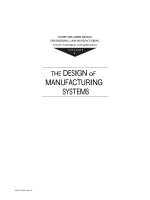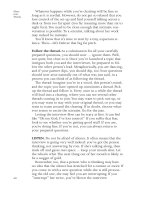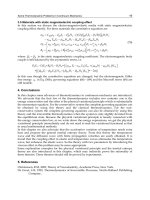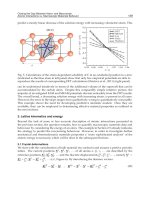The Design of Manufacturing Systems Part 9 pptx
Bạn đang xem bản rút gọn của tài liệu. Xem và tải ngay bản đầy đủ của tài liệu tại đây (78.43 KB, 2 trang )
Two industrial case studies are presented. They were selected from a range of cases studied to identify
and prove the existence of the three engineering paradigms introduced above. These cases have been
chosen to illustrate the three different approaches to environmental protection outlined through the
individual paradigms. Furthermore, the identification of clean technology characteristics in the cases
selected has been taken as a proof that paradigms are changing in industrial practice.
Two Industrial Case Studies
Shell
A project was carried out with Shell on the abandonment of an oil platform [6]. The task was to evaluate
possible abandonment options and suggest the best option to the project team. Criteria for the selection
of the best option included economic considerations, safety issues, public acceptance, and environmental
TABLE 5.1 The Three Paradigms of Industrial Environmental Action
Paradigm
Criterion Dilute and Disperse
Clean-Up Technology (End-of-
Pipe Engineering)
Clean Technology (Preventative
Engineering)
Leitbild Linear thinking,
linear processes
Linear thinking,
linear processes
Holistic, ecological thinking,
cyclical activities
Motivation for
action
No motivation for
environmental
protection
Extrinsic motivation for defensive
and reactive actions
Extrinsic and intrinsic motivation
for environmental protection,
opportunity seeking
Kind of activity None Purely technical Managerial, strategic, technical
Participants in
activity
No activity Specialists Participation across the
organization
Organizational
development
No development Some specialist learning,
development of environmental
specialists
High level of organizational
learning throughout the
enterprise and beyond
(e.g., stakeholders)
Production Continuous growth Continuous growth Minimized production with focus
on quality
Production
process design
Unchanged
processes
Unchanged process, technology-
centered solutions leading
mainly to add-on technology
Changed processs, cyclical closed-
loop, or cascaded production
process
Product design No concern for
environmental
impacts
No design changes, recycling of
products
Design for the environment,
design for minimization
of life cycle impacts
Material
consumption
Unrestrained Unrestrained (possibly increased
due to additional processes)
Minimized over the (product)
life cycle
Pollution Unrestrained, dilute
and disperse
Restrained through additional
process, concentrate and contain
Minimized over the (product) life
cycle, if possible, rendered
harmless
Global
environmental
impact
Not accounted for Aim to reduce, is it successful? Minimized through proactive
activities
Industrial output Product to be owned
by user
Product to be owned by user Provision of services, product on
lease, servicing and recycling by
producer
Financial cost for
environmental
protection
No investment Additional cost for add-on
technology
Investment into process change,
saving of running and treatment
costs
Profit Largely based on
non-accounting of
environmental
resources (free
commodities)
Partly achieved through avoiding
legal penalties, also through
saving of secondary treatment
costs
Largely achieved through
innovation, savings for
minimized material
consumption, and pollution
control and treatment
© 2001 by CRC Press LLC
© 2001 by CRC Press LLC
6
Model-Based
Flexible PCBA
Rework Cell Design
6.1 Introduction
6.2 Overview of Printed Circuit Board
Assembly Technology
Printed Circuit Board • Surface Mount Components • Surface
Mount Component Assembly Processes • Through-Hole
Components • Through-Hole Assembly Processes
• Manufacturing Assembly Defects and Rates
6.3 Rework Technology and Assembly Robots
PCBA Rework Requirement • Industrial Rework
Equipment • Robots and Automated PCBA Rework
6.4 Overall Development Planning
6.5 Detailed Studies of Rework
Manual Rework Procedure • Factors Affecting Rework
• Thermal Considerations and Problems • Preheating • Heating
6.6 Determination of Reflow Methods and Automated
Rework Techniques
The Effect of Reflow Methods on Automation • Reflow Method
Selection • Alternative Proposals for Automation • Hot Air/Gas-
Based Surface Mount Component Rework • Iris-Focused
Infrared-Based Surface Mount Component Rework • Soldering
Iron-Vacuum Desoldering Iron-Based Through-Hole Rework
• Solder Fountain-Based Through-Hole Rework • Comparison
of Alternative Reflow Methods
6.7 Determination of Other Rework Requirements
Rework Tools • Sensory Control System • Supervisory System
6.8 Development of Core Automated
Rework Procedures
6.9 Equipment and Rework Tools Selection
Manipulating Devices and Controllers • Reflow and
Resoldering Devices • Reflow Control Devices • Other Rework
Tools • Auxiliary Robot Tools • Control Equipment
6.10 Subsidiary Automation of Tools
6.11 Top-Down View of System Architecture
6.12 Detailed Automated Rework Procedures
6.13 Total System Modeling Requirements
Physical System Modeling Requirements and Analysis
6.14 Robot and Vision System Software Development
Necdet Geren
University of Çukurova









